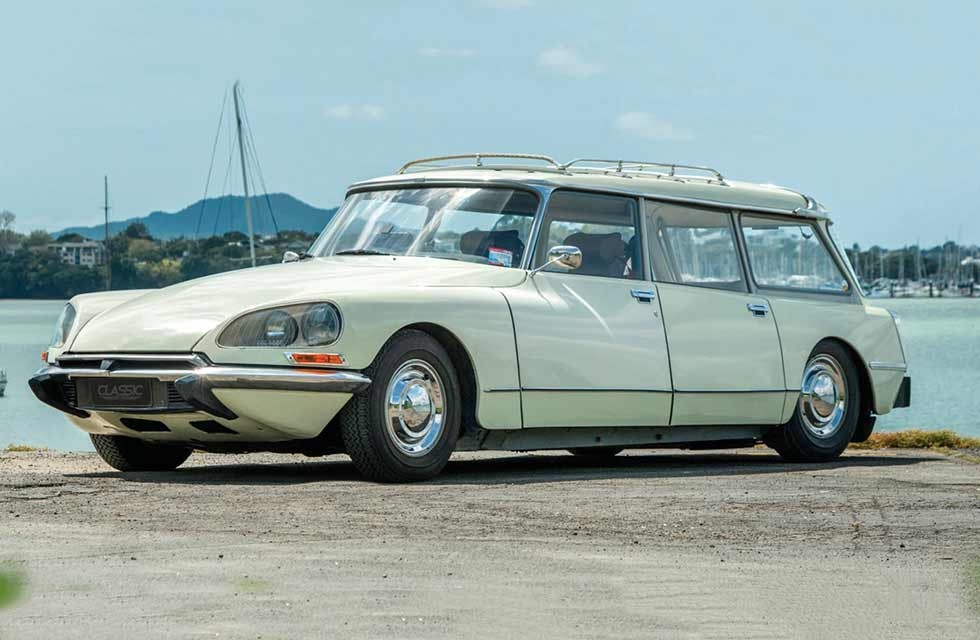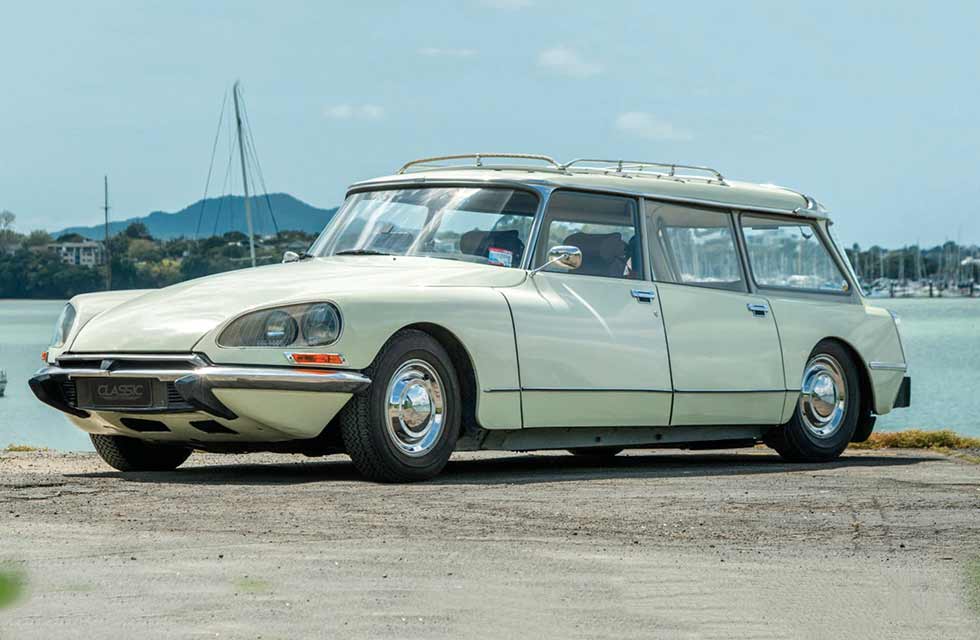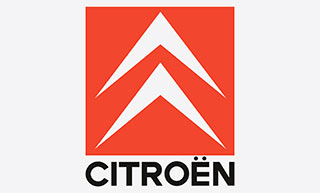
Longue Déesse Purchased brand new in New Zealand, this Safari DS23 is a genuine time capsule classic, its remarkably good and totally original condition down to the care taken by the Kiwi couple who owned this car for the first 40 years of its life. Words Allan Walton. Photos Stephen Perry.
CELEBRATING CITROËN’S CENTENARY
Un Siècle D’innovation – Classic Safari: This amazing example of Citroën’s seven-seat estate, a DS23 Safari, has only ever had two Kiwi owners from new and remains in totally original condition – a truly amazing time-capsule classic
The relatively small number of cars that plied the roads of the small English town I grew up in during the early 1960s were mostly the rather dull British saloons so prevalent during that time. A Zephyr or a Sunbeam Rapier was regarded as being something rather exotic, and even the new MGBs – usually driven by flat-cap, duffle-coated, pipe-smoking gents – were rarely seen. The odd lawyer or doctor from the more affluent end of town might occasionally be spotted wafting by in their Bentley or, in at least one case, a huge Pontiac Laurentian. Catching a glimpse of a Jaguar or an Aston Martin was a once-in-a-year occurrence, while the chances of coming across a fancy Italian Alfa Romeo or Ferrari was about as likely as going out tomorrow and finding yourself parking alongside a Bugatti Chiron at your local PAK’nSAVE.

So, I can remember quite distinctly spotting my very first Citroën DS even though I would only have been eight or nine at the time. Resplendent in a coat of pale blue with a white roof, there it sat – like something out of a 1960s science fiction movie – at the kerbside. In hindsight, it must’ve been an earlier model as it still had open headlights; those later, iconic enclosed headlights that swivelled around with the steering, made their debut on the 1968 models, around 5-6 years before I spotted ‘my’ Citroën. The car was already drawing a crowd of admirers, mostly young schoolboys such as myself, and I can’t even begin to imagine how the DS must’ve looked to those who were around when it was first unveiled at the Paris Motor Show in October 1955.
Evidently it made a major impression on an awful lot of people, as Citroën took no less than 12,000 orders – on just the first day of the show!
Many years later, I found myself driving a DS at the head of a friend’s wedding procession, with his soon-to-be wife in the rear seat of the car. It wasn’t a task I’d been expecting but rather was pressed into, as the relative originally expected to be at the wheel had begun his celebrations a little too early and was rather the worse for wear. Sinking into the Citroën’s squishy front seat, I was given a brief beery-breathed lesson on how the car’s column change worked, and the button on the floor was pointed out as being the brake ‘pedal’.
With the engine already running, I eventually found first gear, slipped the clutch, and the long nose of the DS rose upwards as we slid out into the traffic. The first surprise involved the car’s steering, super light but very precise, and it took a while for me to get used to it, but by the time I arrived at the church it had grown on me.
I was less comfortable with the brakes. Travelling mostly in town traffic, my tyro DS driving skills needed much more practice, and although they never complained, I’m sure both bride and mother were unimpressed by my decidedly erratic braking. However, other than that, the Citroën’s ride was magic carpet-like, especially when compared to the conventionally sprung British cars I was more used to. With the ability to simply glide over road irregularities, it’d be hard to find something as smooth to drive as a DS. I believe the BBC used Safaris as camera cars during the 1960s as they were the only car to provide a good enough ride to capture action smoothly; this being in the days before Steadicams.
My brief drive with the owner of our featured Safari doubled down on this aspect of the Citroën’s abilities as we swept over sleeping policemen at speeds that would have your head bursting through the roof of any other vehicle.
As for the car’s looks – well, the DS still has the ability to turn heads and in many ways still seems otherworldly, something that was very noticeable as we photographed our Safari – passers-by simply couldn’t resist stealing a closer look at this rather amazing-looking machine.
Even today, 64 years after it first appeared, the Citroën DS is still a truly impressive piece of automotive engineering – its ground-breaking, space-age looks are simply the cherry on top. Incroyable!
CONCEPTION ET INGÉNIERIE
The DS was styled by Flaminio Bertoni, an Italian sculptor who later found his true vocation as an automobile designer. As well as the DS, Bertoni also penned the Traction Avant, the 2CV, the Ami 6 and the cute H van with its corrugated side panels. André Lefèbvre, who worked as an engineer for Voisin and Renault, engineered the DS while that unique hydro-pneumatic suspension system was the invention of Paul Magès who joined Citroën in 1936 as a technical draughtsman. His first major automotive work would be on the 2CV’s suspension setup. Magès followed up his work on the DS with the later development of the DIRAVI speed-sensitive power-steering system that first saw the light of day in the Maserati V6-powered Citroën SM.
Usually referred to as the ‘Goddess’ – a term derived from the pronunciation of ‘DS’ being the same as the French word for goddess, déesse – the car as originally launched in 1955 was simply packed with innovative thinking. The car’s unique hydro-pneumatic system not only powered the usual braking and steering, but also worked the car’s clutch, the transmission and, of course, Citroën’s unique self-levelling full independent suspension – the closed hydraulic system being pressurised to 2490psi by an engine-driven pump. This suspension setup had been trialled earlier by Citroën on a Traction Avant.
On the first cars, Citroën specified the use of a vegetable oil for the system, the so-called ‘red’ hydraulic fluid. However, due to its waterabsorbing (hygroscopic) characteristics, this type of fluid increased the possibility of pressure loss due to seal deterioration, especially in cars that were used infrequently. As a result, in 1967 Citroën switched over to a new LHM, mineral oil-based fluid that wasn’t as damaging to the seals within the system. This later fluid was incompatible with the seals used on the previous models, so switching to the new fluid was not possible for owners of earlier cars. Citroën signposted the difference by using a green dye for the LHM fluid and all parts of the DS’ hydraulic system, previously painted black, were now painted green.
DETAILS SPÉCIAUX
In the cabin, other unique features included the steering wheel that appeared to sprout organically from the dashboard on a single ‘shoot’. Quite remarkable. And as we strolled around our featured Safari, the owner pointed out some of its many novel features. These included the lift-up seats that are normally hidden under the flat floor of the car’s load bay. This bay, long in itself, can be further lengthened by simply dropping down the rear tailgate. A second registration plate allows the car to be driven legally with the rear door open, clever.
Another special feature that further illustrated just how much attention Citroën paid to every last little detail is the front bar of the factory-fitted roof rack. Made from aluminium to keep weight down to a minimum, a close inspection of the front bar shows that it had been manufactured to resemble a long stick of twisted barley sugar. This twist in the bar is designed to cut down wind noise when cruising along – just one little detail that marks this Citroën out as being something rather special.
VARIATIONS DE MOTEUR
Despite all its innovative technical specifications, there was one area where the DS was rather less cutting edge – its engine. Citroën’s initial concept was to power the DS with an air-cooled horizontally opposed engine, rather like that of the Porsche 911. However, the proposed flat-six engine never appeared and instead Citroën were forced to fall back on the old-fashioned overhead valve four-banger as used in the 11CV Traction Avant. This 1.9-litre engine was hardly going to set the performance world alight, producing a mere 56kW. This 1930s motor was made to look even older by mating it to the newly developed hydraulically operated four-speed semi-automatic gearbox fitted to the DS – a fully automatic transmission would not be available until 1971 for the DS21 and 23.
A new 1985cc engine appeared in 1965 for the DS19a, with the 2.1- litre DS21 model arriving the same year. The final DS23, introduced in 1973, was fitted with a 2.3-litre engine, with either carburettors or fuel injection, the latter being the most powerful version with 105kW on tap. The DS23 estate versions had to make do with carburettors.
SUR SAFARI EN NOUVELLE-ZÉLANDE
When Bill and Janet Parsonson were married, their first car was a Vauxhall and later they would also tour around New Zealand in a Mini. However, Janet’s first close encounter with French cars would come following an overseas trip to France. Back in New Zealand, the first Citroën they saw would be a DS during the early 1960s. Immediately taken by the car’s futuristic appearance and with Janet taking the lead, the couple quickly decided that this was the car for them, and they soon became proud owners of an ID19, an entry-level version of the DS with a detuned engine and minus the pneumatic aids that made the more expensive DS so unique, the car being purchased in Palmerston where Bill was working for Winstone Steel.
Later, they took the chance to upgrade the ID, placing an order for one of the 10 Citroën Safaris that the New Zealand agent planned to import into the country in the early 1970s.
Backtracking a little, the station-wagon version of the DS first appeared in 1958, gaining a multiplicity of names, including Break, Estate, Wagon, Station-Wagon and, in Australia, the term that most Kiwis will be familiar with – Safari. Citroën also produced two other versions of this model, the Familiale with three folding seats located between the front and rear seats (the latter fitted further towards the rear of the vehicle) and an ambulance with a split rear seat so that it could accommodate a stretcher.
Bill and Janet’s French-built 1973 model was delivered to them in 1974, having travelled from the factory in France to the UK and thence to New Zealand.
When they ordered the car, they decided on a rather unique option when it came to choosing the car’s colour scheme. Normally Safaris feature two exterior colours, bearing in mind that the car’s body is essentially a frame onto which all the panels are bolted. The body itself, including roof and rear door, would usually be painted in light grey, while remaining body panels would be painted in another colour. Bill and Janet decided that the roof and rear door should be finished in the same colour, ivory, while the body frame retained the usual shade of grey. Local Citroën enthusiasts believe this colour choice is unique. Details of this paint scheme are noted on the car’s original build sheet which, of course, they filed away and kept.
Being careful owners, Bill and Janet immediately took measures to keep their new car rust free by applying a liberal dose of Fishoilene (later, when finally selling the Safari, Bill pointed out that the Fishoilene made the Citroën very popular with the local cats for a few weeks). They also ensured that the car’s interior was equally well cared for, immediately fitting covers to all the car’s seats and also laying down several carpets on the rear deck to ensure that future loads such as suitcases or camping gear wouldn’t scratch and damage the painted floor. These measures proved successful and the Safari’s wonderfully soft and comfortable seats still look like new, as does the rear load space with its novel pop-up seats.
If all that wasn’t enough, an enviable collection of spare parts for the Safari was assembled and meticulously catalogued, with the date purchased and the price paid for each item carefully logged onto Kalamazoo index cards that also indicated each part’s location within the series of storage boxes set aside for the Citroën spares.
PARTIE DE LA FAMILLE
During their time with the Safari, Bill and Janet toured through the South Island with the car full to the brim with their children and camping gear, an easy task for the Safari with its excellent load-carrying capacity. In 1976 they joined the Waikato Citroën Club, and in later years, the couple would continue to prove their passion for the French marque through ownership of a 2CV and a diesel Xsara.
Bringing our story closer to the present day, 2014 to be precise – and by this time with their children having flown the coop and now retired – the Parsonsons had owned their Citroën Safari for four decades. However, they were beginning to find the lengthy Safari a bit of a handful when it came to driving and parking and started thinking about selling the car. It was at this stage that the Auckland-based enthusiast who would eventually purchase the car appeared on the scene. A long-time lover of Citroëns, he had known of the Parsonsons’ Safari for some time, and when news filtered through the grapevine that it might be up for sale he sprang into action.
Having arranged to meet Bill, Janet and the Safari, a sale price was negotiated, and keen to ensure that he acquired the car – as the couple’s resolve to part with it began to weaken – the new owner confirmed the deal by pulling out his iPad, connecting to his bank account and transferring the dollars into their account on the spot. (Bill and Janet’s carefully documented cache of spare parts wasn’t part of the deal. However, a month or so later, the new owner was given first option on the parts and they also changed hands. As the Safari’s present owner remarked, these spares are part of the car’s ‘story’ and should be kept with it.) At the time of the Safari’s sale, Bill and Janet had owned this gorgeous French classic for 40 years, so quite understandably they were extremely sad to part with a car that had become a part of their family – and the car’s new owner recalled how they shed a few tears as their pride and joy was driven away from the kerbside on the way to its new home in Auckland.
While putting together this article, we got in touch with Bill and Janet, who now live in Hamilton, and talked briefly to Bill who shared a few thoughts about the Safari. It was evident that they still miss their Citroën, so we’ll be posting a copy of this magazine to Bill and Janet as a memento of the car they loved, drove and cherished for all those years.
1973 Citroën DS23 Safari
Engine Four, inline
Capacity 2347cc
Bore/Stroke 93.5mm x 85.5mm
Valves Pushrod OHV
Max. Power 84.5kW @ 5500rpm
Max. Torque 183.5Nm @ 3500rpm
Fuel System Weber 28/36DM2
Transmission Four-speed manual
Suspension Independent all-round via oleo-pneumatic compression chambers. Double transverse arms and anti-roll bar (F); Single trailing arm and anti-roll bar (R)
Steering Rack-and-pinion, PAS
Brakes F/R Disc/drum
Dimensions:
Wheelbase 3125mm
Track (F/R) 1516/1316mm
Overall Length 5026mm
Width 1803mm
Weight 1435kg
Performance:
Max Speed 171kph
0-62mph (0-100kph) 12.5 seconds
Standing ¼ mile 18.5 seconds
Average Economy 9.8–14.5 litres/100km (12.7 combined)
Production Totale: Safari/Familiale (1958-1975) 93,919






